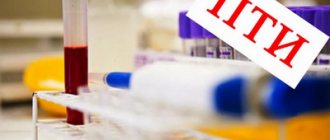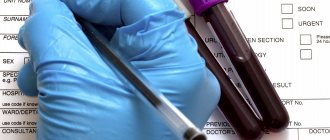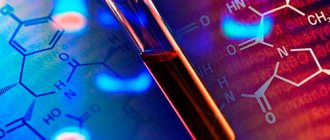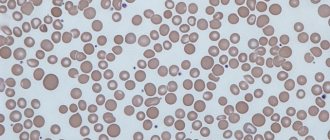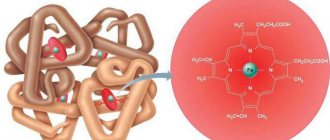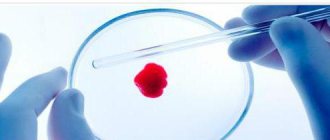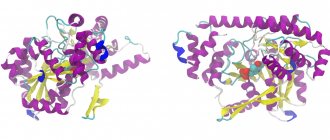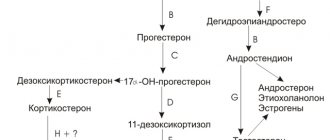What is fibrinogen
The human body itself produces its own means of defense. These substances are synthesized by different organs - the bone and brain, endocrine glands, etc. The liver is responsible for the production of fibrinogen - a protein that serves to protect the body from large blood loss due to damage to blood vessels. When interacting with a number of enzymes, the protein is converted into the basis for the production of blood clots - fibrin threads and in this form enters the blood plasma. Monitoring its content in plasma is important. A high level can cause vascular thrombosis, a low level can cause hemorrhage.
Fibrinogen - what is it and what effect does it have on the female body?
Fibrinogen is a special protein that can dissolve in aqueous media. This compound is produced in liver tissue. This substance belongs to blood clotting factors. The renewal of this compound in the blood occurs in just 2-5 days. In the blood, the protein remains inactive. Only at the moment of need it is activated. At this time, the connection leads to the formation of a clot, blocking bleeding. Additionally, fibrinogen functions include:
- restoration of blood vessels affected by inflammation;
- regulation of the process of dissolving blood clots;
- participation in the creation of vessels;
- participation in the regeneration of damaged mucous membranes and skin.
Normal levels of this protein are extremely important for women. Good blood clotting is an important condition for the absence of complications during pregnancy and labor. In addition, fibrinogen is involved in the regulation of blood loss during menstruation. However, elevated protein levels contribute to the development of thrombosis and its dangerous consequences.
Fibrinogen blood test
It is important to know what fibrinogen is in a blood test. This is the first most important plasma coagulation factor, the monitoring of which is mandatory during preoperative examination to determine the state of hemostasis and reduce the risk of bleeding. Deciphering the analysis will help assess the body’s tendency to produce blood clots. The content of this substance is determined by a biochemical study of venous blood.
Only attending physicians and specialized specialists - therapists, surgeons, cardiologists, gynecologists, hematologists - can prescribe an analysis and interpret its results. In order for the study to show real values, you must stop 6-8 hours before the collection:
- eating;
- use of drugs that affect blood clotting;
- physical and emotional stress;
- smoking.
- The liquid part of human blood is plasma
- System and types of hemostasis - tests for gene disorders and mutations, normal indicators
- Platelet aggregation in the blood
Fibrinogen norm by age
The age norm is given in the table:
| Patient group | Norm | |
| g/l | µmol/l | |
| Adults | 1,78-4,50 | 5,2-13,1 |
| Newborn baby | 0,95-2,45 | 2,8-7,1 |
| Children under 5 years old | 1,70-4,05 | 4,93-11,7 |
| Children under 10 years old | 1,57-4,00 | 4,6-11,6 |
| Children under 16 years old | 1,54-4,48 | 4,5-13,0 |
Fibrinogen level in blood
When blood fibrinogen is higher than normal, it is very important to know what this means for adults and children. The unit of measurement for protein levels is grams per liter (g/L). The norm for a person is determined by the range of 2-4 g/l, for a newborn - 1.25-3 g/l. Deviations are observed both upward and downward. Depending on the reasons, drug treatment is not always required: during pregnancy, fibrinogen normalizes on its own after childbirth, and for colds, after recovery. Protein is produced by the liver, so deviations may be the result of a disruption in its functioning.
What analysis is it determined by?
To determine the level of fibrinogen in the blood, a study such as a coagulogram is performed. To perform the analysis, blood is taken from a vein on an empty stomach. You should stop taking medications and smoking. This may affect the analysis results.
It is not recommended to conduct the study if there are signs of a cold. This may affect the correctness of the result. Additionally, to assess the activity of this substance, blood tests such as ATCV and antithrombin 3 are performed. In the list of detected enzymes, fibrinogen is called Factor 1. Its content varies g/l.
Fibrinogen is increased
Hyperfibrinogenemia is called increased fibrinogen in the blood. With a strong impact on the body, accompanied by tissue damage (surgery, burns, trauma, infectious diseases), the level increases, sometimes up to 10 g/l. This is explained by the body’s desire to prevent blood loss through damaged vessels: in an emergency, a clot should form to help slow down and completely stop bleeding. If the tissue is not damaged and the protein level is high, it is caused by another disease.
During pregnancy
High fibrinogen is observed during pregnancy and childbirth. Its plasma content of 6 g/l can be considered normal. Values higher even in the last trimester of pregnancy are considered deviations, so doctors regularly prescribe a coagulogram - a test that reflects the blood clotting ability of the pregnant woman’s body. For minor deviations, the woman is observed and periodically prescribed advanced diagnostics. Drug support is limited to small doses of Aspirin, Dipyridamole, Folic acid, and B vitamins.
Increased fibrinogen
An increase in fibrinogen content (fibrinemia) is a significant indicator for diagnosing a number of diseases and indicates activation of the hemostatic system. When the level of this protein rises above 4 g/l, thrombus formation processes can be triggered, causing negative consequences. The exception is pregnant women, whose normal value is too high. An increase in blood clotting leads to serious disorders of the cardiovascular system. At the same time, the erythrocyte sedimentation rate (ESR or ROE) increases.
Causes
Studies have shown that the coagulation system is very sensitive to changes in the body's condition. Fibrinogen is increased when:
- inflammatory, infectious and autoimmune diseases - influenza, pharyngitis, pancreatitis, peritonitis, pyelonephritis, glomerulonephritis, pneumonia, rheumatoid arthritis, mononucleosis, scleroderma;
- circulatory disorders in the brain, limbs - atherosclerosis of the arms and legs, thrombophlebitis, angiopathy, venous insufficiency;
- oncological diseases, multiple myeloma;
- stroke, myocardial infarction;
- nephrotic and hemolytic-uremic syndrome;
- diabetes mellitus, hepatitis, tuberculosis;
- hypothyroidism, amyloidosis;
- burns, injuries;
- hyperfibrinogenemia;
- tissue necrosis, radiation sickness;
- nicotine addiction;
- during pregnancy and menstruation in women;
- after surgery;
- at the first stage of DIC syndrome;
- in older people.
Consequences
An increased concentration of protein in the blood causes blood clots to form even in the absence of damage. This can cause the development of coronary heart disease, blockage of blood vessels with fibrin clots, heart failure, heart attack and stroke. The blood becomes thicker and more viscous, which is dangerous with hypertension in old age.
How to reduce fibrinogen
To adjust fibrinogen levels, the doctor individually selects a treatment regimen taking into account the reasons causing this deviation. There are several groups of drugs that differ in their mechanism of action on the blood system. The following anticoagulants are distinguished:
- preventing the action of the enzyme thrombin on fibrinogen (Heparin);
- partially inhibiting the synthesis of prothrombin by liver cells (Warfarin, Dicumarin);
- thrombolytics that dissolve an already formed blood clot (Alteplase);
- coagulation factor X inhibitors (Xarelto (Rivaroxaban), Pradaxa);
- foods that help thin the blood and reduce its clotting (cranberries, raspberries, turmeric, pineapple, lemon, decoction and tincture of licorice root, green tea, flaxseed oil, beets, cucumbers, garlic, cocoa beans, dark chocolate, fatty fish, aloe juice);
- vitamins A, C, E, B3, B5 as additional means.
Causes of increased fibrinogen in the blood
Sometimes high protein levels are a consequence of a hereditary disease of the hemostatic system. Much more often, elevated fibrinogen indicates the possibility of:
- myocardial infarction;
- stroke;
- malignant tumor;
- burns, injuries;
- ulcers, sepsis, tissue destruction;
- previous surgery;
- colds or infectious diseases (flu, tuberculosis);
- acute inflammatory disease, pneumonia;
- regular smoking.
Laboratory symptoms confirm that increased fibrinogen is a risk factor contributing to the occurrence of a wide range of cardiovascular diseases and serious physiological abnormalities. A decrease in protein content can also signal a danger to human life and health. The reasons for the decrease may be: lack of vitamins B and C, liver diseases - cirrhosis, acute hepatitis, malignant blood diseases, snake bites.
- APTT - what is it in a blood test. Normal indicators, reasons for increased or decreased APTT
- Rivaroxaban - Xarelto
- Reasons for increased hemoglobin in the blood in men and women - reduction with folk remedies, medications and diet
Causes of deviations and methods of correcting fibrinogen levels
There are many factors that can provoke an increase in the level of this substance in a woman’s blood. To identify the pathology that caused the disorder, a comprehensive examination is required.
Often, such a disorder occurs in women due to hormonal changes during menopause. In this case, hormonal drugs are selected for the patient. In women during pregnancy, such a deviation may indicate a pathology of its course. In this case, additional studies are prescribed to assess the viability of the fetus and the risks for the woman.
The reasons for the increase in the level of this substance may lie in pathologies of an infectious and autoimmune nature, accompanied by a pronounced inflammatory process. Such diseases include:
- rheumatoid arthritis;
- pneumonia;
- stomach ulcer;
- vasculitis, etc.
In addition, an increase in fibrinogen levels can occur against the background of various types of cerebrovascular accidents. The presence of a large amount of this substance indicates the presence of bleeding. Often such a disorder is detected in women who have a long history of smoking.
Burns and traumatic injuries to the skin can also cause an increase in protein levels. An increase in the amount of this coagulation factor is often observed during the acute phase of myocardial infarction. This problem often occurs in acute and chronic nephrotic syndrome. Recent surgery can create conditions for an increase in blood clotting factor levels.
Danger during pregnancy
If the protein level in the plasma of a pregnant woman deviates greatly from normal, simple observation will not be enough. Excess can provoke:
- spontaneous abortion;
- undeveloped pregnancy;
- premature birth;
- placental abruption;
- pathology of the umbilical cord vessels.
When severe deviations occur, further monitoring of pregnancy, regardless of the phase, must be carried out together with a hematologist, who will monitor protein levels and, if necessary, adjust treatment. Births in women with high protein levels should take place in specialized clinics and should be attended by qualified personnel.
Features of fibrinogen levels during pregnancy
During pregnancy, a woman’s body adapts to a favorable gestation of the fetus. Good blood clotting is the key to an easy birth without complications such as bleeding and large blood losses. Fibrinogen levels during pregnancy differ by trimester, having their own characteristics, as well as physiological orientation.
In the first trimester, the egg is fertilized and implanted into the walls of the uterus. Under the influence of hormones that control this process, the level of fibrinogen decreases slightly, which allows the fertilized egg to gain a foothold in the uterine cavity.
The norm during pregnancy in the first trimester is 1-3 g/l.
The second trimester is characterized by the development of all vital organs and systems, as well as the prevention of bleeding and the development of premature birth. Therefore, the level of fibrinogen in the second trimester increases rapidly and reaches 4-5 g/l. This process helps prevent the occurrence of unwanted complications, and also helps in the full development of the fetus.
In the third trimester, when blood tests are taken more often than usual, normal values can reach 5-6 g/l, which is also due to natural physiological processes in the body of the expectant mother. Maximum indicators are diagnosed before childbirth, when the body is preparing for the upcoming process with possible blood loss. A high level of fibrinogen helps protect the female body from large blood losses, as well as ensure rapid rehabilitation after suffering stress.
Ask your question to clinical laboratory diagnostics doctor Anna Poniaeva. Graduated from the Nizhny Novgorod Medical Academy (2007-2014) and Residency in Clinical Laboratory Diagnostics (2014-2016).Ask a question>>
How to lower fibrinogen
The most accessible way to adjust protein levels in the body is to choose the right diet. There are many natural products of both plant and animal origin that can affect blood clotting. A properly selected diet can serve as a prevention of vascular thrombosis and an effective additional agent that increases the effect of medications during treatment.
Reduce fibrinogen levels:
- green tea;
- sea fish;
- raspberries;
- beet;
- onion;
- cranberry.
Foods that increase fibrinogen levels:
- buckwheat;
- eggs;
- potato;
- spinach;
- cabbage.
Dosed physical activity also leads to a decrease in protein content. Among medications – preparations based on acetylsalicylic acid:
- Aspirin;
- Aspecard;
- Cardiomagnyl.
These are proven, publicly available medications that inhibit enzymes that synthesize thromboxanes, polyunsaturated acids responsible for blood clotting. Fibrinolytics can be taken as prescribed by a doctor, but their careless use leads to serious physiological complications. Heparin or Clexane, drugs that interfere with the blood clotting process, will help reduce deviations from the norm.
Elevated fibrinogen levels - what does it mean?
The fibrinogen protein must be contained in the body within certain parameters. As its mass increases, irreversible consequences begin. Therefore, it is necessary to promptly find out the source of development of the pathological condition.
Changes in an adult - reasons
If plasma fibrinogen is elevated, this indicates the presence of a number of problems:
- Impaired blood flow, arterial pathology, etc.
- Autoimmune diseases.
- Infectious and inflammatory processes.
- Oncology.
- Hepatitis and other liver dysfunctions.
- Kidney failure.
- Heart attack and stroke.
- Diabetes.
- Lack of thyroid hormones.
- Tuberculosis.
- Hyperfibrinogenemia.
- Injuries, burns.
- Nicotine addiction.
- Surgical procedures.
- Tissue necrosis.
- DIC syndrome.
- Radiation sickness.
- Pregnancy.
Physiological restructuring of the body in older people
Protein levels also change in older people due to physiological changes in the body.
Why does it change in children?
Fibrinogen in a child may increase due to the presence of problems:
- Rheumatism.
- Diseases of an autoimmune and allergic nature.
- Poisoning.
- Iron deficiency.
- Atopic dermatitis.
Parasitic infestations and intestinal infections may occur.
Increased fibrinogen in the coagulogram
From the results of a coagulogram you can learn about the following problems:
- The onset of DIC syndrome.
- Risk of developing thrombocytosis.
At the same time, D-dimer and prothrombin time increase, and antiphospholipid syndrome is detected. Indicators of thrombin time, prothrombin index, coenzymes, and antithrombin fall.
During late pregnancy, the fibrinogen level is most often too high.
The role of fibrinogen and why is it determined in the blood?
The complex of functional biological systems that regulate the liquid state of blood circulating through the vessels in liquid form is called hemostasis. When the integrity of the blood vessels is damaged, a clot forms, which “clogs” the damage and helps stop bleeding. The basis of the thrombus is fibrin, which is transformed from fibrinogen under the influence of the second coagulation factor - thrombin.
In the human body, this plasma protein performs the following functions:
- participates in the formation of a blood clot;
- influences the rate of scarring of lesions;
- regulates the processes of blood clot dissolution;
- promotes the growth of blood vessels;
- affects the vascular wall during inflammatory processes.
Fibrinogen in the blood should not be lower than 2.0 mg/l; if this indicator decreases, any injury or surgical intervention can be fatal for the patient; if the values are increased above 4.0 mg/l - this characterizes a high risk of thromboembolic complications
Practitioners prescribe a blood test for fibrinogen:
- with an inflammatory process of unknown etiology;
- suspicion of pathological processes in the cardiac and vascular systems - the patient has dyspnea, painful sensations behind the sternum, radiating to the scapular region, lower jaw and left upper limb;
- preparation for surgery;
- predicting possible complications in the postoperative period;
- liver diseases;
- anemia;
- autoimmune pathologies;
- malignant processes;
- pregnancy;
- diagnosing hemophilia, a rare hereditary pathology associated with impaired blood clotting processes.
Determination of fibrinogen content is part of a complex biochemical study - “rheumatic tests”, which is carried out to diagnose systemic pathological processes.
Fibrinogen test, indications
The determination of fibrinogen in venous blood is included in the spectrum of such a wide laboratory study of the performance of the coagulation system of hemostasis as a coagulogram. The indications for its use are varied. The most common ones are the following:
- preparation for surgical procedures (including gentle and microinvasive interventions);
- postoperative period;
- diseases of the circulatory system (require constant monitoring of the rheological properties of blood; a timely test for fibrinogen will help prevent thrombosis of blood vessels);
- diseases of the hepatociliary system (liver diseases, for example, viral or toxic hepatitis), in these conditions the synthesis of fibrinogen by damaged liver cells will also be impaired;
- inflammatory processes of unknown etiology (fibrinogen, together with C-reactive protein and some other proteins, form a group of so-called acute phase proteins);
- pregnancy (fibrinogen test is taken in each trimester, unless otherwise indicated);
- suspicion of hemophilia.
The main clinical value of testing for fibrinogen is that it is a unique marker of the risk of ischemic, and subsequently necrotic processes in the body.
That is, when the analysis shows fibrinogen above normal, the likelihood of spontaneous thrombus formation in the lumens of blood vessels increases significantly. In particular, the coronary arteries or vessels supplying the brain may be affected, which can ultimately lead to the development of a heart attack or ischemic stroke. The situation is aggravated by the patient's hypertension and dyslipidemic syndrome.
Fibrinogen in the human body
Fibrinogen is synthesized by liver cells and, along with other proteins, enters the bloodstream. It is colorless, easily soluble in liquids and has a large mass. In addition to the fact that fibrinogen is much heavier than other proteins, it is capable of creating blood clots, so its increased amount affects another test, namely ESR (erythrocyte sedimentation rate). If fibrinogen is higher than normal, ESR levels will increase.
At the same time, this protein easily penetrates into the extravascular space and is found in lymph and connective tissues. In severe pathologies, its amount outside the blood can reach 80% of the total volume in the body.
We have already talked a little about fibrinogen standards. The content of this protein in the blood of healthy people is highly stable; its amount does not change depending on the time of day, gender and age of people. The exception is newborns and pregnant women; rates also increase slightly in older people.
Fibrinogen is characterized by a high rate of renewal in the body; its half-life is three days. From 1.5 to 5 grams of protein are produced daily. And in a day the body is able to renew up to a third of the total volume present.
The importance of blood testing for fibrinogen
The fibrinogen blood test requires traditional preparation, in which food should be avoided for at least eight hours before blood collection. Therefore, you should not be separately puzzled by the question of how to take a blood test for fibrinogen. Blood is taken from a vein and placed in a tube with an anticoagulant. It is necessary to carry out repeated analyzes to observe the dynamics of the ongoing processes of formation and release of fibrinogen.
It is advisable to carry out repeated tests to determine the dynamics. For this purpose, there is a coagulogram, which reflects with maximum completeness the factors that influence the process of hemostasis and are directly involved in it.
Why is a blood test for fibrinogen prescribed? Fibrinogen is an extremely important protein for the human body and, first of all, for its hematopoietic system. Deciphering the blood test for fibrinogen gives the attending physician the basis for diagnosing diseases and their subsequent treatment.
An increased content of it leads to platelet formation, and a decreased content leads to uncontrolled bleeding. To prevent this, it is necessary to control the level of fibrinogen mass. A timely blood test for coalogram and fibrinogen will help establish the correct diagnosis and prescribe timely treatment.
The indicator is increased: causes and consequences
| The normal level of fibrinogen in females is: | |
| up to 1 year | 1.3-2 g/l. |
| 2-6 years | 1.7-3 g/l |
| 6-14 years | 1.7-3 g/l |
| 15-25 years | 2-4 g/l |
| After 35 years | 1.8-4 g/l |
Protein norm for females: 2-4 g/l (grams per liter), but on critical days the indicators are often inaccurate, this is due to natural changes in the body when hormones temporarily increase the thickness and coagulability of blood to prevent major bleeding.
Therefore, it is better to conduct research 3-5 days after the end of menstruation. Increased protein levels can be observed in patients taking medications containing steroid sex hormones. If its concentration is much higher than the permitted limits, then this indicates inflammation or some problems in the body.
For example:
- Acute inflammatory and infectious diseases.
- Oncology.
- Complicated hypothyroidism.
- Tissue death.
- Rheumatoid arthritis.
- Autoimmune diseases.
- Peripheral artery disease.
- DIC syndrome (in the early stages of the disease).
- Amyloidosis.
- Pregnancy.
- Tuberculosis.
- Pneumonia.
Often this protein compound is temporarily higher than the permissible norm, this is influenced by the following factors:
- Critical days.
- Recent transactions.
- Fresh burns and wounds.
- Cold.
During pregnancy, the levels increase to 6.5 g/l - this is considered normal, since, in this way, the body is rebuilt for successful childbearing. If the protein concentration remains the same or decreases, then this indicates serious violations.
At different stages of pregnancy, the following data are generally accepted:
- Up to 3 months – 2.5-5 g/l.
- 3-6 months – 2.5-5.1 g/l.
- 6-9 months – 3.7-6.1 g/l.
Fibrinogen (the norm for women by age, the table of which is given in the article, may fluctuate slightly) in a healthy girl can increase or decrease, since the female body is very sensitive to hormonal changes.
For example, during menopause, due to a slowdown in the functions of the reproductive system, a decrease in protein may be observed, which is a natural phenomenon. Low levels of this protein indicate the inability of the plasma to produce the necessary blood clots during injury.
This is a rather serious violation, since too little blood, unable to clot at the right time, can cause great harm to the body. And fibrinogen, which does not reach 1 g/l, indicates health problems.
Reasons for decreased performance:
- Liver failure.
- Diseases of the digestive system in which vitamin K is not absorbed.
- Lymphoblastosis is benign.
- Toxicosis, in which the body practically does not absorb food, because of this, the balance of essential microelements is disrupted.
- Leukemia.
- Vitamin deficiency (lack of vitamins C and B).
- Hereditary fibrinogenopenia.
- Erythremia.
- Disease of the heart and blood vessels.
- DIC syndrome.
- Acute intoxication.
- Recent heavy bleeding.
- Alcohol addiction.
- Vegetarianism.
- Prolonged and uncontrolled use of blood thinning medications that contain Aspirin.
- Use of hormonal and anabolic drugs.
- Polycythemia vera.
- Consumption of fish oil.
Inflated indicators usually do not affect your well-being in any way; for this reason, this problem often goes unnoticed. Which is quite dangerous, since this indicates a high concentration of protein, which thickens the blood and complicates its movement through the veins.
https://www.youtube.com/watch?v=o94ikVJc6L0
This action is serious in 2 cases: a blood clot can block a large artery and then deform it. Or, on the contrary, he will move without difficulty, once hit in the heart. Where it will cause blockage of the valves, which will lead to its stop and inevitable death.
A high concentration of protein during pregnancy is quite dangerous, since very thick blood can cause the following disorders:
- Thrombosis and thrombophlebitis.
- Placental abruption and spontaneous miscarriages.
- Frozen fruit.
- Birth of premature babies.
- Formation of gestosis.
- Umbilical cord thrombosis.
Low levels of protein (not reaching 1 g/l) are dangerous due to internal hemorrhage, since any careless body movement can activate damage to large arteries, which can lead to serious health problems.
To determine blood clotting, a special examination is prescribed - a coagulogram, which is prescribed if there are such indications:
- Before and after operations.
- Liver diseases.
- Diseases of the cardiovascular system.
- Pregnancy.
- Uncertain pathological changes in the body.
- Suspicion of hemophilia.
- Use of indirect anticoagulants (warfarin, acenocoumarol).
- Bleeding.
- DIC syndrome.
- Constant miscarriages, stillbirths.
Fibrinogen in the blood of women at different ages (according to the table) differs from each other, for example, if the levels reach 2-4 mg after 15 years, then this is considered normal. A higher protein concentration may indicate the presence of infections and viruses, while a lower concentration may indicate problems with the liver or a lack of vitamins.
For the most accurate examination results, the following rules must be followed:
- The activity must be done in the morning, 1-2 hours after sleep.
- The last meal should be 9-12 hours before collection.
- You need to get a good night's sleep before the test.
- Drinking coffee and alcoholic beverages before the event is prohibited.
- It is advisable to refrain from consuming nicotine for 2-2.5 hours.
- Immediately before the coagulogram, you need to drink 200-250 ml of purified or mineral water without gas.
- 15 minutes before the event, it is not advisable to be nervous and overexert yourself, and reduce physical activity to a minimum 2-3 days before the coagulogram.
The accuracy of the examination also depends on the professionalism of the laboratory itself. A patient taking a medication that affects clotting should notify health care providers.
The level of fibrinogen depends on age:
- for men - 2–4 g/l;
- for women - 2–4 g/l;
- for newborns - 1.3–3 g/l;
- in childhood for boys and girls - 1.25–4 g/l.
During the period of bearing a child
the indicator reaches
7 g/l, as the body prepares for delivery, which may involve bleeding. The risk of bleeding increases if the protein concentration is below 2 g/l.
In a healthy person, fibrinogen is not decisive in assessing the risk of cardiovascular disease. But a deviation from the normal value of 1 g/l is a reason for a medical examination, especially for people over 50 years old: then fertile ground is created for the development of dangerous pathologies.
The concentration of fibrinogen is determined by studying the coagulogram - indicators of blood clotting. Separately, protein content is determined in a biochemical blood test. Fibrinogen is one of the factors of “rheumatic tests”.
This protein is an independent risk factor for pathologies of the heart and blood vessels. Elevated levels of fibrinogen in the blood, regardless of the cause, are associated with a risk of blood clot formation.
An increase in fibrinogen concentration indicates an increase in blood clotting function and a disruption in the process of thrombus formation. This increases the likelihood of cardiovascular pathologies such as stroke, heart attack, especially in combination with high blood pressure.
This dependence is especially often observed in young and middle age. High scores may indicate development
atherosclerosis
.
Medical studies have found that in deaths due to heart attack and stroke, protein levels were higher than in correctable crises and heart attacks. At the same time, a greater relationship was observed with the concentration of fibrinogen in the blood plasma than with other indicators, including cholesterol in the blood.
Changes in the blood formula are associated with diseases of peripheral vessels - obliterating atherosclerosis of the lower extremities, diabetic angiopathy, thrombophlebitis, chronic venous insufficiency.
A relationship has also been established between the likelihood of recurrent myocardial infarction or stroke and fibrinogen levels, if the level is significantly higher than normal - about 7.5 g/l, and this means that the level needs to be especially monitored after the initial attack.
When observing the factor:
- it is possible to identify risk groups in the early stages in order to take preventive measures to prevent the development of dangerous diseases of the heart and blood vessels;
- determine the severity of the pathology, prognosis;
- evaluate the effectiveness of therapy.
Also, based on a high level of fibrinogen in the blood, one can suspect:
- inflammation of internal organs due to viral, bacterial infections, autoimmune diseases;
- tumors;
- hypothyroidism (underfunction of the thyroid gland);
- amyloidosis;
- pulmonary diseases - pneumonia, tuberculosis;
- death (necrosis) of tissues (including the heart);
- injuries.
A coagulogram may show an increase in the level of fibrinogen in the blood for other reasons:
- during menstruation;
- after surgery;
- from taking hormonal medications with estrogen (female sex hormone);
- at low ambient temperatures.
For inflammatory processes, menstruation and pregnancy, treatment is not prescribed - the indicator stabilizes on its own when the condition normalizes.
Protein concentrations above 7 g/l in expectant mothers have serious consequences - early spontaneous abortion, underdevelopment, premature placental abruption, gestosis, thrombosis, thrombophlebitis, including the pulmonary artery.
The norms of mass fractions of fibrinogen, accepted by modern clinical studies in various people:
- adults (men and women): 2–4 g/l;
- pregnant women (maximum values for the third trimester): 6–7 g/l;
- in newborns: 1.25-3 g/l.
To determine the level of fibrinogen, venous blood is taken for analysis. The test must be taken on an empty stomach (not earlier than twelve hours after eating). For two hours before taking this test, you must avoid physical activity. And forty minutes before donating venous blood, it is important to avoid smoking.
Fibrinogen above normal means that the hemostatic system is activated and there is a danger of excessive blood clot formation, or an acute phase of an inflammatory process, usually severe, is occurring in the body.
Formation and administration of fibrinogen
Fibrinogen belongs to a group of glycoprotein proteins that are formed in liver cells. It is a colorless protein dissolved in blood plasma. The average content of this protein in fibrinogen is 2-4 g/l. Fibrinogen forms the basis of the hemostatic system. Fibrinogen itself determines the process of blood clotting, its presence and speed in general. This process is extremely important for the body, especially in case of violation of the integrity of blood vessels.
Fibrinogen performs the following functions in the human body:
- promotes the formation of a fibrin plug, affects wound healing, is directly involved in vascular synthesis (antiogenesis), the interaction of body cells, affects the composition of blood and arteries when an inflammatory process occurs.
The normal amount of fibrinogen in the blood determines the presence or absence of certain diseases. The fibrinogen mass value indicates the protein content: normal, decreased (hypofibrinogenemia) or increased (hyperfibrinogenemia).
Fibrinogen is higher than normal - what does this mean?
If fibrinogen is elevated, this means that there is a risk of blood clot formation and, as a result, the development of stroke, coronary heart disease and heart attack.
The causes of fibrinogen above normal may be inflammatory and autoimmune processes in the body, hormonal abnormalities and some diseases:
- inflammatory diseases of various etiologies and localizations, both autoimmune and infectious - pancreatitis, pharyngitis, pneumonia, pyelonephritis, rheumatoid arthritis, mononucleosis and others;
- impaired cerebral circulation;
- cancerous tumors, in particular multiple myeloma;
- pathologies of blood vessels in the periphery - thrombophlebitis, angiopathy in diabetes, venous insufficiency, atherosclerosis of the extremities;
- acute myocardial infarction;
- injuries and burns;
- nephrotic syndrome;
- become addicted to nicotine;
- diabetes;
- pregnancy;
- recent surgery;
- hepatitis, tuberculosis;
- Stage I of DIC syndrome.
Fibrinogen levels also increase as a person ages.
Reasons for decreased fibrinogen
The absence of this plasma protein in human blood (a-fibrinohemia) leads to the fact that blood coagulation does not occur, and with its deficiency, a loose, crumbling clot is formed. Deficiency of coagulation factor I is called fibrinogenopenia, which can be either congenital or acquired.
Low fibrinogen concentration is characteristic:
- for genetic pathologies - von Willebrand and Werlhof diseases, hemophilia;
- dysfunction of the hematopoietic system;
- thrombohemorrhagic syndrome;
- liver failure;
- bone marrow lesions;
- toxicosis;
- meningitis;
- penetration of amniotic fluid into the circulating bloodstream during cesarean section;
- chronic myeloid leukemia;
- prostate carcinoma;
- lack of cyanocobalamin and vitamin C in the patient’s body.
Poisoning of the body with toxic substances, large blood loss during difficult childbirth and surgical procedures can reduce the level of fibrinogen.
Reduced fibrinogen in the blood is typical for people who adhere to a vegetarian diet, as well as those taking:
- steroid male sex hormones – androgens;
- fish fat;
- anabolic steroids – substances that enhance the processes of building muscle mass, increasing strength and endurance;
- substances that neutralize free radicals - antioxidants;
- medications that inhibit blood clotting activity and prevent the formation of blood clots - anticoagulants.
Diagnosis of changes in fibrinogen levels
Fibrinogen is a laboratory indicator that is determined as part of a blood test for coagulation indicators - a coagulogram. At the same time, the following basic indicators are determined:
- Blood clotting time is the period between the onset of bleeding and its stopping after a finger is punctured with a scarifier, normally from 30 seconds to 3 – 5 minutes.
- Prothrombin index (PTI) - the ratio of the clotting time of the control sample to the clotting time of the test blood is 93 - 107%.
- Prothrombin time is the period of conversion of soluble fibrinogen into fibrin, 15 - 18 seconds.
In various laboratories, additional indicators of the various stages of blood coagulation may be carried out in adults and children.
- surgical interventions are always accompanied by damage to blood vessels during tissue incisions; for successful prevention of bleeding, knowledge of the state of the coagulation system is necessary;
- liver diseases;
- in the complex diagnosis of infectious diseases, tumors, heart attacks and blood diseases.
Symptoms of high fibrinogen levels
High levels of fibrinogen in the blood usually do not cause any symptoms, so it is difficult, if not impossible, to associate any disorders with it.
For this reason, very often high levels of fibrinogen go undetected, since the person does not experience symptoms of its increase.
| Fibrinogen, along with other proteins, including C-reactive protein, belongs to the category of acute phase proteins. They are produced by liver cells in the presence of tissue damage or infection, increase their strength and participate in the response of the systemic inflammatory process. Recent studies have linked increased fibrinogen concentrations to an increased risk of cardiovascular disease and, therefore, an increased likelihood of experiencing a myocardial infarction or stroke. |
Increased fibrinogen is exclusively a laboratory sign. This means that you can see it in the results of a coagulogram, but it cannot be identified by characteristic symptoms that are simply absent.
Experienced doctors can only suspect a violation of the hemostatic system when it becomes difficult for them to give an intravenous injection.
Consequently, the fact that fibrinogen increases often goes unnoticed, which is why the necessary therapeutic measures are either not carried out at all or are prescribed with a significant delay. This is the insidiousness of this disorder in the functioning of the hemostasis system, since untimely correction of fibrinogen content poses a serious threat to the body.
